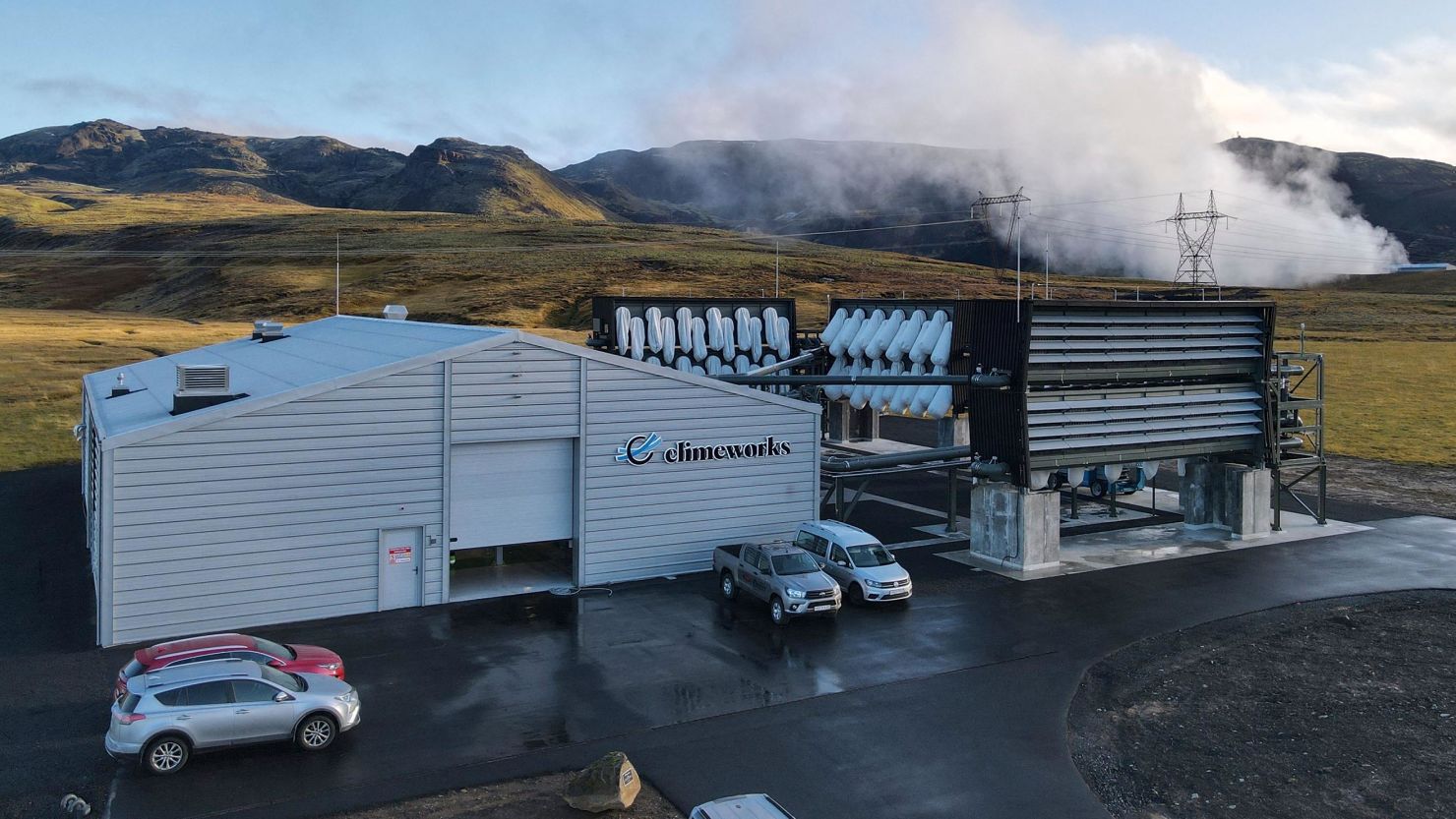The window to prevent catastrophic climate change is closing. Concentrations of planet-warming carbon pollution in the air are at their highest level in more than 2 million years – and the world has yet to even hit peak fossil fuel emissions.
The crisis is so urgent that scientists and governments are scrambling to find ways to remove some of this carbon pollution from the air, and to capture what’s still being produced by power plants and industrial facilities.
Long considered controversial, these techniques are increasingly landing a starring role in climate policies.
In its 2022 report, the United Nations’ Intergovernmental Panel on Climate Change said that “all available studies require at least some kind of carbon dioxide removal to reach net zero” – where the world removes as much planet-heating pollution from the atmosphere as it emits.
Even if emissions fall significantly, the world would still need to remove between around 10 to 20 billion tons of carbon dioxide every year, according to the IPCC.
Very few people claim that carbon capture and removal alone will solve climate change.
“There’s no silver bullet here,” said Howard Herzog, Senior Research Engineer in the MIT Energy Initiative, who has studied carbon capture for four decades. But it’s “a tool in our portfolio” of options, he told CNN.
Others, however, fear that this is a reckless bet on technology that is expensive, unproven at scale and too far away from full development to provide a meaningful answer to the climate crisis.
And they criticize these technologies as a dangerous distraction from policies to cut down fossil fuel use.
What is carbon capture?
“Carbon capture” is often used as catch-all term for what are actually two sets of technologies – carbon capture and carbon removal. But there are important differences.
Carbon capture reduces the amount of carbon pollution that would otherwise go into the atmosphere by catching it at the source of pollution, then storing it or reusing it.
It works like this: Instead of sending carbon pollution (or “flue gas”) from burning fossil fuels up a smokestack and into the atmosphere, it is trapped and put through a chemical process.
The most common way to do that, said Herzog, is to put the flue gas into contact with a liquid solvent, which pulls the CO2 out in a process called chemical scrubbing. The CO2 is then compressed to knock out the water and sent by pipeline, or sometimes by ship, to a location where it can be reused or stored.
For long-term storage, “really the only option is to put it deep underground,” Herzog said. This requires the right geological conditions. Sandstone, a porous rock, is particularly good, he said, and a layer of denser rock on top like shale will stop the carbon seeping through.
The captured carbon can also be reused to make other products, such as chemicals, fuel and cement. But the climate benefit will depend on how long the carbon is trapped. Captured carbon used in carbonated drinks, for example, will just escape right back into the air.
Another way captured carbon has been used, and one which has helped make this technology controversial, is in a process called “enhanced oil recovery.” The carbon is pushed into wells to to force out the hard-to-reach remnants of oil – allowing fossil fuel companies to squeeze more from aging oil fields.
What is carbon removal?
Carbon removal refers to a slew of different techniques which aim to remove carbon pollution that is already in the atmosphere and lock it up permanently.
Trees and oceans are natural carbon sinks – they remove more carbon from the atmosphere than they contribute.
“But as more carbon dioxide enters the atmosphere, it is harder for nature to do its job,” Jan Mazurek, senior director of the carbon dioxide removal program at the non-profit ClimateWorks Foundation, told CNN.
So, humans are trying to develop ways of speeding up carbon removal.
Some techniques are low-tech, such as mass tree planting. Others seek to supercharge natural processes, like seeding the oceans with nutrients to increase the growth of carbon-storing marine life, or spreading crushed rock on land to cause chemical reactions that capture carbon from the air.

“Biochar” involves burning wood, leaves and dead plants in a low oxygen environment to produce a form of charcoal, which can be added to soil like a fertilizer to increase crop growth.
Other carbon removal technologies have similarities to parts of carbon capture.
One, called bioenergy with carbon capture and storage, involves planting trees or crops, which take up carbon from the air, and then burning them to produce energy. The carbon pollution created is trapped and stored by injecting it deep underground.
Direct air capture, possibly the most high-profile carbon removal technique, uses machines to suck in air and then extracts the carbon using chemicals. This can then be injected deep underground or reused.
What stage is the technology at?
Many of these technologies are at an early stage, remain prohibitively expensive and are a long way from being big enough to have a significant impact.
Carbon removal technologies may need to be scaled up by a factor of 1,300 by 2050 to meet the Paris Climate Agreement pledge to limit temperature rise to 2 degrees Celsius above pre-industrial levels, according to a January report led by authors from the University of Oxford – and few countries have plans to do this.
Roughly 2 billion tons of carbon dioxide are currently removed globally every year and only a tiny fraction – 0.1% – comes from technologies such as direct air capture, the report found.
There are 18 direct air capture plants operating globally, all small-scale. Together they remove around 10,000 tons of carbon a year, according to the International Energy Agency.
The Orca plant, run by Swiss company Climeworks in Iceland, claims to be the world’s largest, with capacity to remove 4,000 tons of carbon dioxide a year.
The difficulty is that, while the amount of carbon dioxide in the atmosphere is rising very quickly, it still makes up only about 0.04% of air. That makes removing carbon directly from the air significantly more energy-intensive and expensive than removing it from smokestacks, where carbon concentrations are far higher.
When it comes to carbon capture and storage, there are approximately 35 commercial facilities in operation around the world, according to the International Energy Agency, capturing nearly 50 million tons of carbon a year.
While there are hundreds of these facilities in development, even if all they all start operating, “deployment would remain substantially below what is required in the Net Zero Scenario,” said the IEA on its website.
What are governments doing to scale it up?
The Biden administration has provided incentives for carbon capture and removal under the Inflation Reduction Act, including through tax credits.
In December, the US announced $3.7 billion to “kick start” a carbon capture and removal industry.
“No matter how fast we decarbonize the nation’s economy, we must tackle the legacy pollution already in our atmosphere to avoid the worst effects of climate change,” US Energy Secretary Jennifer M. Granholm said in a statement at the time.
What’s still holding many of these technologies back is the economics, Herzog said. A coal plant without carbon capture, for example, is always going to be much cheaper to run than one with carbon capture, unless policy changes.
Proposed regulations to cap the amounts of planet-heating pollution from US power plants could help. The new rules wouldn’t mandate carbon capture technology but would incentivize it.
Other countries are doing more, Herzog said. “In Europe, the policies are becoming stronger and forcing industry to react.”
The EU, which already has an emissions trading system putting a price of around $100 on each ton of carbon pollution, has set a target to store at least 55 million tons of CO2 annually by 2030.
Why are these technologies controversial?
Every form of carbon removal or capture comes with questions and potential problems.
There are concerns over the amount of land required for mass tree planting or for bioenergy with carbon capture and storage, and the possibility that could clash with land needed to grow food.
Direct air capture remains very expensive, and despite big industry promises that costs will plummet as the technology develops, there’s a long way to go to see if this is plausible, Herzog said.
This technology also requires huge amounts of clean energy to run, said Holly Buck, Assistant Professor of Environment and Sustainability at the University at Buffalo, adding to the demand as the world looks to electrify everything from cars to homes.
“There’s going to be a lot of demand for this new renewable capacity. Policymakers have to be really smart about figuring out where that goes,” she told CNN.

There are also concerns about the impacts of transporting and storing carbon, a key feature of carbon capture and several carbon removal techniques.
Pipelines can leak, potentially contaminating drinking water and causing health problems. More than 40 people needed hospital treatment after a carbon pipeline leaked in Mississippi in 2020.
“The pipeline needs to be built the right way, in the right places and well monitored,” Buck said. “That, I think, is one of the major challenges. It’s addressable, but it requires really good regulation and monitoring.”
Perhaps one of the most persistent criticisms of these technologies is their potential to distract from policies to phase out fossil fuels and instead give polluters a license to keep polluting.
In 2021, hundreds of organizations signed an open letter to President Joe Biden and top lawmakers in Congress, arguing that “technological carbon capture is a dangerous distraction.”
“It is the fossil fuel industry’s excuse for inaction and delay,” Lili Fuhr, Director of the fossil economy program at the Center for International Environmental Law, told CNN.
But others say it cannot be an either-or question.
“We are now, unfortunately, at a point where we can’t leave any option off the table to avert dangerous warming,” Mazurek said.
There are going to be industries, such as cement, that are all but impossible to decarbonize in the near-term, said Herzog. It’s here carbon capture and removal technologies will be needed. “That’s not a distraction,” he said, “That’s a solution where there’s no other solution.”
Still, he added, “the best way to remove CO2 from the air is not to release it into the air in the first place.”







